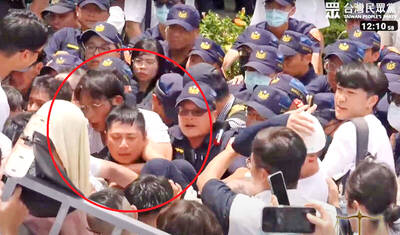Ousted Iraqi president Saddam Hussein was hanged inside one of his former torture centers yesterday in the final act of a brutal 30-year tragedy that left the stage strewn with tens of thousands of corpses.
Officials who witnessed the execution said the 69-year-old former strongman remained defiant to the last, railing against his Iranian and US enemies and praising the rebels who have pushed Iraq to the brink of civil war.
Iraqi Shiites, persecuted during Saddam's 24-year rule, feted his end as a dream come true, dancing and hammering off bullets while Sunni extremists slammed the deceitfulness of the US-backed government for hanging their hero.

PHOTO: AP
Iraqi state TV showed a brief film of Saddam being placed in a noose by masked hangmen, cutting away just before his execution.
Hussein appeared calm, chatting to his burly, leather-jacketed executioners as they wrapped his neck first in black cloth then a thick hemp rope and steered him forward on a metal platform.
The gallows was constructed in red-painted metal and was fixed inside a dim room with blue-grey walls. The guards wore black balaclava-style hoods.
Saddam was maneuvered forward firmly but not aggressively by the guards, the grey-bearded prisoner looking thin inside a smart, dark overcoat over a pressed white shirt but no tie.
"He said he was not afraid of anyone," said Judge Moneer Haddad, a member of the panel of appeal court judges who had confirmed Saddam's conviction for crimes against humanity and who attended the pre-dawn execution.
National Security Adviser Mowaffaq al-Rubaie said in interviews that the former strongman's final minutes were lived in the same spirit as his grandstanding appearances in an Iraqi court.
"One thing I can't explain, I have never seen any repentance, never seen any remorse there," Rubaie said.
"When you reach the stage when that's it, that's the end, I think you tend to be right and honest with yourself and confess something," he added.
"But he was praising the mujahidin, he was praising the jihadis ... he was cursing the Persians and he was cursing the West as well," he said.
Rubaie said officials and even executioners had danced around the body afterwards. "This is a natural reaction. These people have lost loved ones."
"The time of death was very, very close to 6am ... It went like a blink of an eye -- he died very, very quickly -- it couldn't have been quicker," he said.
And with that, Saddam stepped off Iraq's political stage for good.
Sami al-Askari, a Shiite lawmaker close to Maliki who also saw the hanging, said it had taken place in an old Saddam-era military intelligence headquarters in the Khadimiyah district of northern Baghdad.
He said the location had symbolic value, because it had been a center of torture and execution under Saddam.
Rubaie said that Saddam's US jailers had handed him over to Iraqis and that there had been no US personnel in the building as the trapdoor dropped and the dictator's life was ended in a "100 percent Iraqi operation."
Hours after the execution, a car bomb exploded in a fish market in the central Iraqi Shiite city of Kufa, killing at least 31 people, but it was not immediately clear whether the attack represented the first reprisal from his supporters.
Saddam and two co-accused -- intelligence chief Barzan Hassan al-Tikriti and revolutionary court judge Awad Ahmed al-Bandar -- were sentenced to death by an Iraqi court on Nov. 5.
also see stories:
Death of Saddam: Dictator's hanging negates the fiction
Death of Saddam: International reaction to Saddam's death is mixed

TPP RALLY: The clashes occurred near the Chiang Kai-shek Memorial Hall on Saturday at a rally to mark the anniversary of a raid on former TPP chairman Ko Wen-je People who clashed with police at a Taiwan People’s Party (TPP) rally in Taipei on Saturday would be referred to prosecutors for investigation, said the Ministry of the Interior, which oversees the National Police Agency. Taipei police had collected evidence of obstruction of public officials and coercion by “disorderly” demonstrators, as well as contraventions of the Assembly and Parade Act (集會遊行法), the ministry said in a statement on Sunday. It added that amid the “severe pushing and jostling” by some demonstrators, eight police officers were injured, including one who was sent to hospital after losing consciousness, allegedly due to heat stroke. The Taipei

NO LIVERPOOL TRIP: Taiwan’s Lin Yu-ting, who won a gold medal in the boxing at the Paris Olympics, was embroiled in controversy about her gender at that event Taiwanese boxer Lin Yu-ting (林郁婷) will not attend this year’s World Boxing Championships in Liverpool, England, due to a lack of response regarding her sex tests from the organizer, World Boxing. The national boxing association on Monday said that it had submitted all required tests to World Boxing, but had not received a response as of Monday, the departure day for the championships. It said the decision for Lin to skip the championships was made to protect its athletes, ensuring they would not travel to the UK without a guarantee of participation. Lin, who won a gold medal in the women’s 57kg boxing

‘NOT ALONE’: A Taiwan Strait war would disrupt global trade routes, and could spark a worldwide crisis, so a powerful US presence is needed as a deterrence, a US senator said US Senator Deb Fischer on Thursday urged her colleagues in the US Congress to deepen Washington’s cooperation with Taiwan and other Indo-Pacific partners to contain the global security threat from China. Fischer and other lawmakers recently returned from an official trip to the Indo-Pacific region, where they toured US military bases in Hawaii and Guam, and visited leaders, including President William Lai (賴清德). The trip underscored the reality that the world is undergoing turmoil, and maintaining a free and open Indo-Pacific region is crucial to the security interests of the US and its partners, she said. Her visit to Taiwan demonstrated ways the

The US has revoked Taiwan Semiconductor Manufacturing Co’s (TSMC, 台積電) authorization to freely ship essential gear to its main Chinese chipmaking base, potentially curtailing its production capabilities at that older-generation facility. American officials recently informed TSMC of their decision to end the Taiwanese chipmaker’s so-called validated end user (VEU) status for its Nanjing site. The action mirrors steps the US took to revoke VEU designations for China facilities owned by Samsung Electronics Co and SK Hynix Inc. The waivers are set to expire in about four months. “TSMC has received notification from the US Government that our VEU authorization for TSMC Nanjing